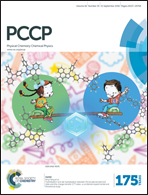Quantum phase transitions in Sn bilayer based interfacial systems by an external strain†
Abstract
Using first-principle calculations, we report for the first time, the changes in electronic structures of a single bilayer Sn stacked on a single bilayer Sb(Bi) and on a single quintuple layer Sb2Te3 induced by both interface polarization and strain. With BL Bi and QL Sb2Te3 substrates, the stanene tends to have a low-buckled configuration, whereas with BL Sb substrate, the stanene prefers to form high-buckled configurations. For strained Sn/Sb(Bi) system, we find that the Dirac cone state is not present in the band gap, whereas in strained Sn/Sb2Te3 system, spin-polarized Dirac cone can be introduced into the band gap. We discuss why tensile strain can result in the Dirac cone emerging at the K point based on a tight-binding lattice model. This theoretical study implies the feasibility of realizing quantum phase transitions for Sn thin films on suitable substrates. Our findings provide an effective manner in manipulating electronic structures and topological states in interfacial systems by using interface polarization and strain, which opens a new route for realizing atomically thin spintronic devices.


 Please wait while we load your content...
Please wait while we load your content...